Kinect Star Wars Review
 Game: Kinect Star Wars
Game: Kinect Star Wars
Developer: Terminal Reality
Publisher: Lucasarts
Available on: Kinect on Xbox 360 only
When watching Star Wars, who hasn’t at one time or another waved around an imaginary Lightsaber, perhaps even providing your own sound effects as well? Certainly most children who grew up with the franchise will have done, but I’m sure most of us, of any age, have pretended, or at least wondered how it would be to wield the mythical weapon. So it is the natural progression of motion controlled videogames to bring our play-acting to life. First it was Dancing Stage, making us feel like dancing queens (and kings). Then Guitar Hero turned all air-guitar players into rock gods, and now, Kinect Star Wars turns a willing sci-fi fan into a fully-fledged Jedi Knight; or at least that is the idea.
STORY: The game is all structured around the fairly flimsy idea that (presumably long after the events of Return of the Jedi) Luke Skywalker has tasked C3PO and R2-D2 with looking after the Jedi Archives on Coruscant. You play a Rebel Commander who, led by the two comedy Droids, can explore the libraries and re-enact famous duels, battles and races, all under the guise of looking back at archived historical records. Not the most compelling way to draw gamers into the action, but it serves as a gateway to both the main quest mode and a selection of Star Wars mini-games.

The main quest mode, entitled Jedi Destiny: Dark Side Rising, is the only mode that really weaves a story of its own, rather than being a standalone mini-game. Players pick a Jedi Padawan of their liking and jump straight into a mission set somewhere in the prequel trilogy; seemingly between episodes one and two. This probably comes as a disappointment to many long-time Star Wars fans, as that immediately rules out such iconic bad guys as Darth Vader and the Stormtroopers. The design decision was presumably taken to allow more flexibility with story and characters but I imagine a quest set in the time of the original trilogy would have captured the hearts of fans more.
The story is all fairly run-of-the-mill Lucas stuff. Young Jedi Padawans have been caught up in the struggle between the Trade Federation and the Republic but the appearance of some new Sith Lords who are set on eliminating the Jedi make things a little more interesting. The game runs parallel with the prequel story canon, and whilst some characters such as Mace Windu and Yoda will appear, this is a separate story in its own right. As such, it unfortunately suffers from a lack of characterisation, and the story doesn’t really carry any weight, it just becomes a way to present players with the different gameplay elements. If more care had been taken to flesh out your playable characters, or if well-known protagonists had been used, the player would have probably cared more about the plot.
GRAPHICS: The Star Wars world is presented in a slightly stylised manner, not so much as the Clone Wars cartoon series, but rather than go for a photo-realistic look, there is a slight cartoony slant on all of the characters. Having simplified models probably makes Kinect mapping somewhat simpler, and the overall effect certainly isn’t a negative one. Of course, it makes Samuel L. Jackson look a little bit strange but, all in all, the characters are pretty effective. Environments are also simplified a little, but the forest world of Kashyyyk (home of the Wookies) for instance looks suitably grand in scale, and space-based starfights do portray the sheer size of the ships and conflict quite well. The game doesn’t exactly push any boundaries graphically, but it is perfectly fine for a game that more or less amounts to a mini-game collection.
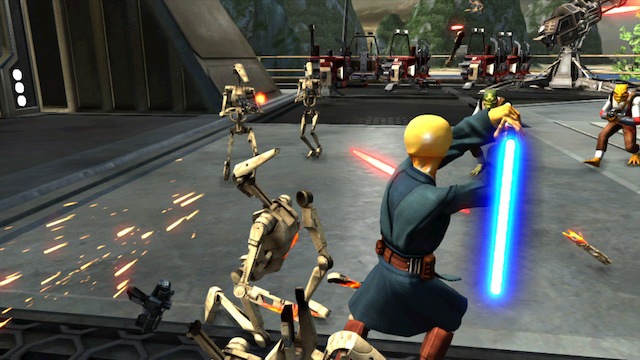
SOUND: The developers couldn’t really go far wrong with the huge audio catalogue they will have been provided access to for producing the game. All of the sound effects have obviously been lifted straight from the films, and the music consists mainly of the work of John Williams, which is always stirring and impressive. His music has become synonymous with the Star Wars films, and as such, fits the game perfectly. Some of the original voice actors for the film series have lent their talents to the game, but where they have not come back to reprise their roles, suitable sound-a-likes have been used and they are almost always spot on (or at least close enough) to the real thing. The overall sound design is exactly as you would expect – polished, deep and immersive.
GAMEPLAY: As the game is split into five main modes, we will look at the gameplay of each separately. As mentioned before, Jedi Destiny is the meat of this title, and will see gamers having to piece together quite a few control types and gameplay elements as they traverse the galaxy. The main bulk is ground-based combat, where players must dodge from side to side, jump over obstacles and dash forward. Unfortunately, the dodging from side-to-side is not always detected very well, and the action required to dash forward, putting one foot forward, is often missed entirely by the Kinect sensor. When you play further back from the sensor this does improve, but it is still far from perfect.
As you progress, you will encounter enemies to defeat. You can either use one hand to slash at them with your Lightsaber, or your other hand which is responsible for using Force powers. Lightsaber moves depend on the direction in which you swing your arm, and whilst it’s not 1-to-1 control, it is fairly accurate at picking up what you are trying to do. As this is so accurate, you can also use the Lightsaber to block and deflect enemy blaster fire, get good enough at it and you can deflect it right back at the enemy to defeat them. Force powers can also be used to push back enemies, throw items at them and even to smash enemies into one another. This all works quite well and you do get the feeling that you are controlling the elements of the force to some extent. Learn how to mix Force powers and the Lightsaber well and your attacks will become very fluid and effective. This is mainly against Battle Droids and aliens however, when you meet a more powerful enemy, you enter into a Duel mode.
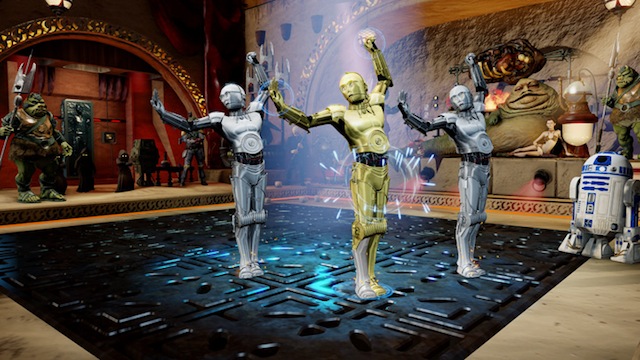
These duels are where the Lightsaber fighting unfortunately takes a real turn for the worse. Every duel, without exception, works in the same way. The enemy attacks and you must block, dodge or repel three or four of their attacks. Repelling attacks will fill your attack meter quickly, blocks will be much slower. Do this successfully and you enter a confrontation where both of you push at each other, with blades entwined. Whoever wins this shoving match gets control of the fight, and this gives you the chance to attack. You then have the length of the aforementioned attack meter to attack the enemy, once the meter runs out, the whole thing starts again with your enemy attacking; rinse and repeat until the enemy is defeated. These fights are so regimented and repetitive that the whole thing becomes quickly tiresome, and all of the fun and excitement of a Lightsaber battle is immediately lost. For what would be the main selling point of the game, the Lightsaber duels are handled poorly and become dull and boring.
In order to add variety to proceedings, there will be other vehicle-based parts of the stages. For example, on the Forest Moon of Endor, there is an extended section where you ride a speeder bike – a’la Return of The Jedi – which is fun, and accurately replicates the experience in the film. You can almost imagine the Ewok sitting behind you on the speeder bike. Another section will see you manning the cockpit in a ship flown by Chewbacca (not the Millenium Falcon). As in the scene in A New Hope, you man the guns and shoot down enemy ships. This too is quite fun, and you direct and shoot with gestures just as you would imagine. This all comes naturally and as such, is fun and straightforward to pick up and play.
Duels of Fate is more or less a spin-off from the Jedi Destiny mode, being extended, standalone duel fights, handled in exactly the same way as those found in the quest mode. Thankfully, this mode does allow for you to re-create famous Lightsaber duels, so you will be able to go one-on-on with Count Dooku or, at last, Darth Vader. However, these fights are identical to those in the main game, aside from setting, the gameplay is still severely lacking, and the novelty of fighting such recognisable bad guys doesn’t make up for this. A pretty shallow and disappointing mode overall.
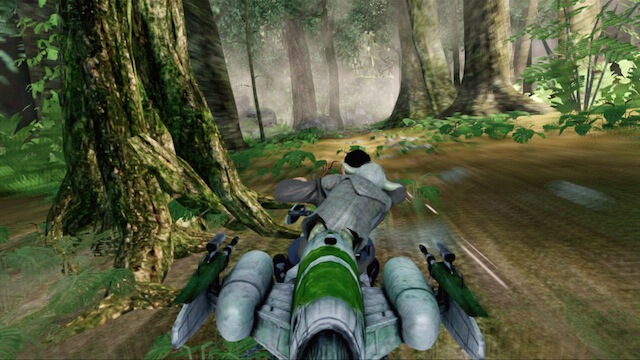
Rancor Rampage is obviously inspired by its Retro arcade namesake, Midway classic Rampage. You (and a friend, if you choose so) take control of a Rancor who has been unleashed and is looking to run amok, causing as much destruction as possible. Players walk on the spot to move, turn their shoulders to turn and swing their arms to smash and destroy; all pretty intuitive stuff. Extra moves such as grabbing civilians, both to throw or to eat (which replenishes your energy) all work exactly as you would imagine, as do ground pound and charge manoeuvres. The game is so easy to pick up and play, and as your goal is to cause chaos, there is instant satisfaction and the gameplay feels gratifying. I mean who doesn’t want to play Godzilla and smash up the city?
To make things more interesting, each level is timed and during that time you are given a list of objectives that randomly appear at the bottom of the screen. Eat 10 people, destroy 3 probe droids, throw a droid 100 metres, completing these improves your score and multipliers, but also gives some direction to the mode. What is nice is that you can choose to complete these objectives, and attain a high score, or you can simply go crazy and do whatever you like. This mode is very straightforward, you can learn the controls and be enjoying yourself within minutes.
The Galactic Dance-Off is self-explanatory too really, you go around the Star Wars universe, taking on well-known characters in dance battles. The presentation is very close to that found in games like Dance Central, and the body tracking is similarly good. Match the moves performed on-screen to score points and gain multipliers, whilst the on-screen opponent will glow red on limbs where you aren’t performing the move correctly. This lets you learn what you are doing wrong and adjust accordingly, working as a built in correction system. The best dance games have featured this for a while now, but it is good to see it in a game which isn’t a dedicated dance title.
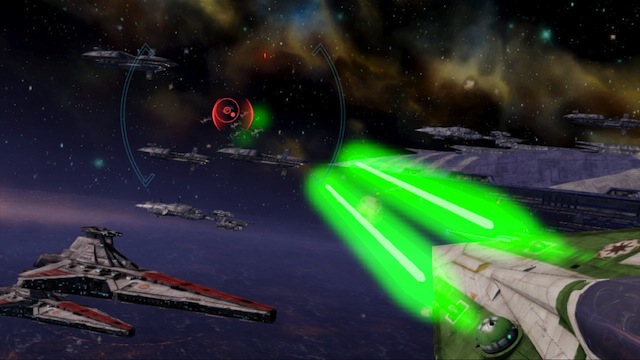
The best part of the Dance-Off mode is undeniably the playlist. The tracks are made up of licensed tracks, such as Bruno Mars and Daft Punk, mixed in with Star Wars themed covers of popular music. For instance, perennial classic “Celebration” and Britney Spears’ pop anthem “Stronger” are both given a Star Wars makeover, with lyrics slightly altered to fit in with the universe. Best of all though is a version of “Ridin’ Solo” by Jason Derulo, which has been changed to “I’m Han Solo”, a popular internet parody song. Facing off against Han himself and Lando Calrissian whilst dancing to this parody tune is hilarious, and even more fun when dancing with a second player.
Last, but not least, is the Pod Racing mode. Already having received the gaming treatment back in the Nintendo 64 days, to positive effect, one wondered what the game could offer which would be different? After playing the title for just a minute or so, you will instantly realise that the controls in Pod Racing are perhaps one of the best ever seen on Kinect. In the film The Phantom Menace, racers had a lever in each hand, that would control speed, braking and turning. In this game, control handles in exactly the same way, but with invisible levers. Turning is handled brilliantly, with subtle movements of your arms being picked up clearly by the Kinect sensor, allowing for some real precision movement.
You do feel the exhilaration when using boosters to speed up and you are hurtling through a tight valley at high speeds. Of course, some fighting power-ups have been included, and you have to keep an eye on the condition of your vehicle, but the heart of this mode is the simple yet effective controls that make you feel like you are right in a real pod race. The races do become a bit repetitive, especially on the harder difficulties where you have to race for several laps on the already-quite-long courses, and this will lead to a lot of arm fatigue, but when played with two players and duelling for the lead, it is a truly great Kinect experience.
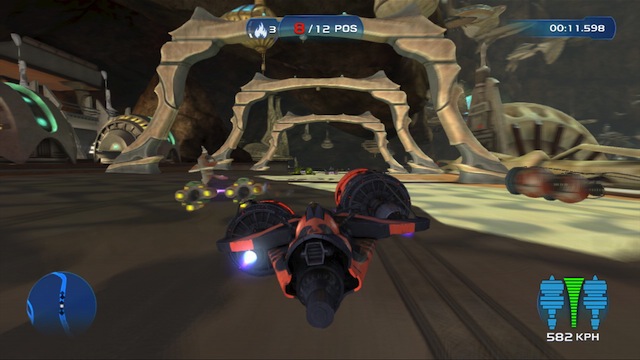
MULTIPLAYER: In the same way that it is handled in Kinect Disneyland Adventures, multiplayer throughout the game is drop-in, drop-out, and players can join or leave whenever they please. This does mean that Achievements and saved games are largely linked to the main profile, but it does allow the title to be quite family friendly, and allow for a very flexible multiplayer experience. Where it does differ from Disneyland Adventures is that instead of the two players being tethered to one another and unable to separate, most of the modes featured in Kinect Star Wars allow for gamers to play split-screen, and therefore have a little more freedom from one another. This will reduce the frustration of feeling pulled around by the main player, but obviously the on-screen action is halved and the game will require you to clear some extra space in your living room as the multiplayer will require a bigger sensor area.
All of the modes allow for 2-player action, so you can play co-operatively to take down the Trade Federation in Jedi Destiny, go head-to-head in a dance battle, or even compete in some fast and furious pod racing action. This does make most of the modes more fun and will add some length to your overall experience – as with most mini-games and a lot of the best Kinect titles, it is more fun when played with a friend.
LONGEVITY: At the end of the day, all of the game modes become pretty repetitive pretty quickly, and the story mode doesn’t do enough to compel you forward to completion, let alone to play through the whole thing more than once. Achievements and unlocking extra songs, new difficulty levels and new characters to play as might make you come back and re-play sections, and this is especially true of the dance mode, where practice of routines will be key to success on higher difficulties. The single-player experience is a little too shallow and repetitive to allow for extended play (not to mention the fatigue aspect of all the flailing around of limbs). Overall the long-term appeal of the game will rely on playing the title in multiplayer, and like with all good mini-game collections, it will most likely shine its brightest in party play.
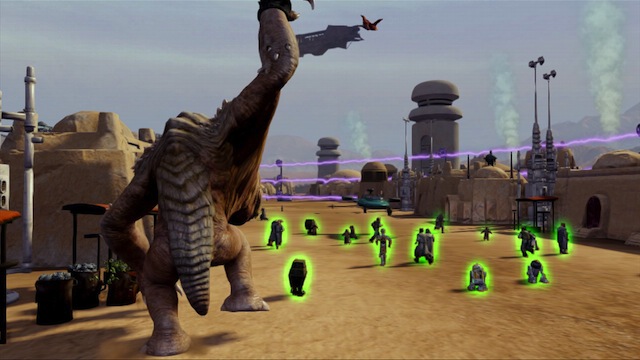
VERDICT: The main let-down to gamers here will be the lack of a pure 1-to-1 Lightsaber fighting mode, and the fact that Lightsaber duelling is so regimented. With it being the mode that most gamers would probably think of first if you mentioned a Star Wars motion control title, it is a shame that the Lightsaber fighting is probably the weakest part of the overall package. The dancing mode is hilarious, and its player detection is so good it is one of the only Kinect dance games to come close to the Dance Central titles. Rancor Rampage is just pure unadulterated fun, and Pod Racing is one of the most intuitive and logical implementations of Kinect control that we have seen yet on the hardware, but Duels of Fate and Jedi Destiny fall down when you get to use the legendary glowing sword; it just isn’t as satisfying or exhilarating as it should be.
Certainly the game works better as a casual title, where gamers are more content with dropping in and out of playing a few quick rounds of any of the game modes. The story-based play isn’t absorbing enough to be a standalone game, and the developers could obviously see that. However, this is a good basis for improvement. If a follow-up title could refine and improve the sword-fighting until it becomes something more like that found in Wii Sports Resort (where tense, frantic battles are the order of the day), then maybe Lightsaber fans will finally have a game they can be proud of. For now, this remains a good collection of mini-games which didn’t quite reach its potential.






